Managing Codling Moth in Home Orchards
Codling moth spray information - Direct link to Corvallis TRAPS station Pest Summary
The worm in your apple
Codling moth is the primary insect pest of apple and pear trees and can destroy an entire crop if uncontrolled. Understanding the moth's life cycle is important for determining management methods and timing of controls. Depending on temperatures, there can be up to three generations of codling moths in Montana per growing season. Multiple chemical and mechanical control measures are available to prevent fruit damage, if implemented properly. Control measures targeting the first generation will be most effective and efficient for preventing crop damage.
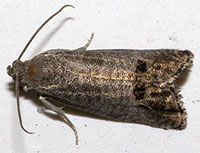 |
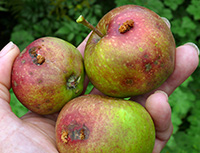 |
 |
|
Adult moth |
Larval entry/exit holes and frass |
Larva (caterpillar) |
Description and life cycle
As temperatures rise above 50°F in the spring, the first generation of moths emerge, mates, and begins laying eggs on immature fruits or nearby leaves. The winged adult phase is ½-inch-long and grayish-brown with a dark copper-colored band at wing tips. Eggs hatch into larvae ¼- to ½-inch-long with cream- to pink-colored bodies and black or brown heads. Larvae feed on young shoots and leaves and later burrow into fruit to feed on the developing seeds. Mature larvae (1/2- to 3/4-inch-long) emerge from the fruit, seek a protected site to pupate (form a chrysalis-like structure), and transform into the next generation. Moths overwinter as larvae by spinning cocoons located on the trunk in cracks and under loose bark or on the ground in debris beneath the tree. In early spring, larvae become pupae for their transformation into adult moths.
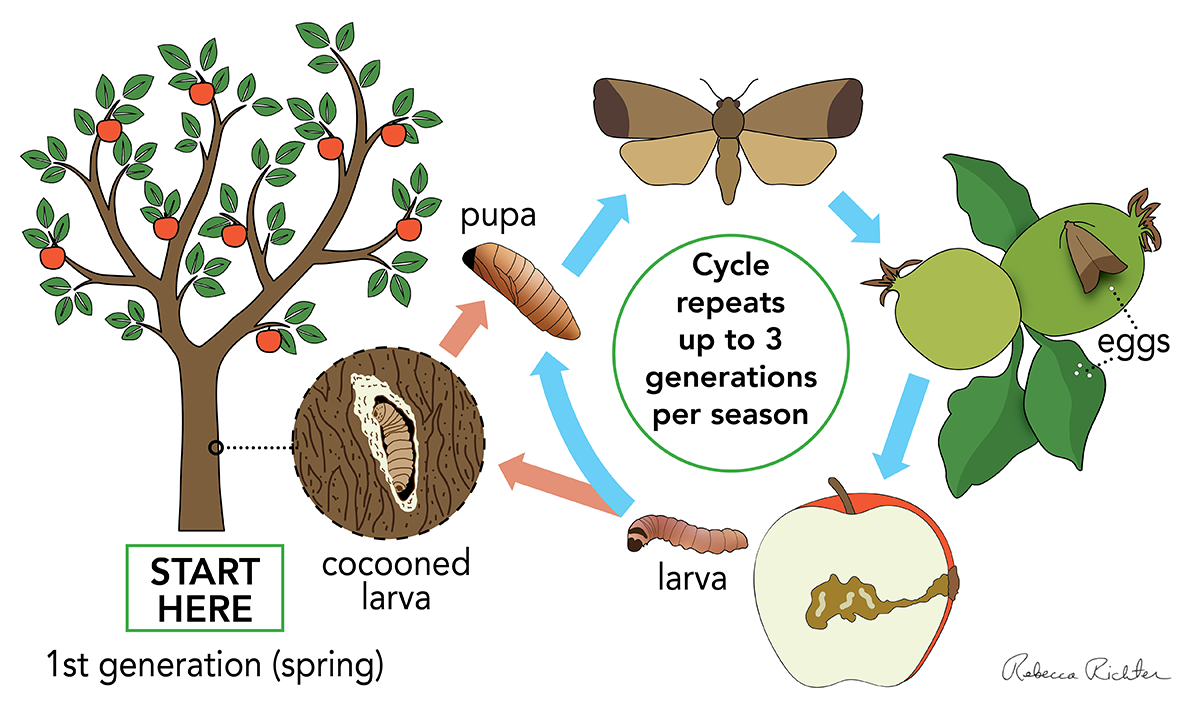
Overview video
Timing of management actions
Biofix and degree-day timeline
Management of codling moth must be timed accurately to be safe and effective. Timing of mechanical controls such as trunk banding and fruit bagging as well as chemical controls are dependent on moth life stage, which is driven by temperature. Therefore, rather than applying codling moth controls on specific calendar dates each year, we recommend using a degree-day (DD) model for a more accurate timeline of moth development and corresponding management actions (see Table 2).
Codling moths usually appear around the first week of May for Zones 5 and 6 and the second week of May for Zones 4 or lower (find your plant hardiness zone here). The term "biofix" refers to a biological event, and here we use it to indicate the date of first codling moth flight in spring. This date is used in the degree-day models and is important because egg-laying soon follows and it is time to begin management for the season. Biofix is traditionally obtained by noting the appearance of winged adults in pheromone traps (below), but the degree-day models can also estimate biofix based on temperatures. For the backyard grower, using the models' estimated biofix options ("fixed biofix" or "no biofix") is adequate, but if you want a bit more accuracy and/or would have fun monitoring a trap in your own orchard, see the next section. We also track biofix at several locations around Montana and will update it on the maps below as the season begins. Direct link to Corvallis TRAPS station Pest Summary.
Monitoring codling moth with pheromone traps
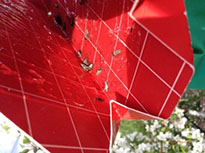 |
| codling moth pheromone trap photo by Zach Miller |
You can obtain a site-specific biofix and track the level of your codling moth infestation throughout the season by using a trap baited with a pheromone lure that attracts male moths. These traps are simply for monitoring and are not an effective control measure. The orange delta-style (triangle-shaped) pheromone trap works best and can be purchased online from various suppliers such as Gemplers and Arbico Organics. Only one trap is necessary for the backyard grower. If you plan to use the trap for monitoring throughout the season, you can purchase additional lures and sticky inserts to replace at intervals recommended by the manufacturer. Hang your trap in an apple or pear tree at the beginning of bloom (at the pink stage) high in the outer canopy and parallel to prevailing winds.
Once you catch your first codling moth, you have determined biofix and can begin using a degree-day calendar with the "trap biofix" or "biofix" option instead of estimated biofix as mentioned above. Note that if you use the TRAPs mobile app degree-day model, you will not be able to input a custom biofix, so a pheromone trap is unnecessary unless you are just curious about your orchard's codling moth populations. If you continue using the trap throughout the season, you may be able to pinpoint first moth flight in second and third generations as well.
For information on correctly identifying codling moths and distinguishing them from sage moths, visit WSU's resource Early Season Codling Moth Monitoring. For more information on setting traps and determining biofix refer to Utah State University's Pest Fact Sheet, "Codling Moth (Cydia pomonella)".
Biofix and spray dates
The spray dates at the locations listed below are based on degree-days from biofix and are reported only for first chemical spray targeting emergence of first generation of codling moth larvae. Subsequent sprays should be applied at intervals according to the product label. Note that suggested spray dates may vary from year to year, and this table will be updated with new information as it is available. If your location doesn't appear in Table 1 or is more than ten miles from any weather station used by either of the CM DD models, we recommend either contacting your local Extension agent using this directory for help determining spray dates for the current year.
| 2021 biofix | 2021 spray | 2020 biofix | 2020 spray | 2019 biofix | 2019 spray | |
|---|---|---|---|---|---|---|
| Anaconda | 5/30 | 6/25 | NA | NA | ||
| Big Timber | 5/19 | 6/7 | 6/4 | 6/28 | ||
| Bozeman | 5/18 | 6/12 | 6/1 | 6/20 | 6/8 | 6/30 |
| Bridger | NA | NA | NA | NA | ||
| Columbia Falls | 5/27 | 6/30 | NA | NA | ||
| Corvallis | 5/14 | 6/9 | 5/15 | 6/11 | 5/15 | 6/13 |
| Darby | 5/31 | 6/22 | 6/3 | 6/28 | ||
| Florence | 5/16 | 6/10 | NA | NA | ||
| Fromberg | 5/11 | 5/20 | 6/1 | 5/15 | 6/12 | |
| Great Falls | NA | NA | 5/17 | 6/24 | ||
| Helena | 5/13 - 5/24 | 5/30 | 6/20 | 5/28 | 6/23 | |
| Kalispell | 6/3 | |||||
| Lodge Pole | 5/16 | 6/5 | NA | NA | ||
| Miles City | 5/16 | 6/5 | 5/19 | 6/6 | 5/13 | 6/15 |
| Missoula | 5/14 | 6/8 | 5/16 | 6/5 | 5/15 | 6/13 |
| Polson | 6/7 | 5/24 | 6/20 | NA | NA | |
| Red Lodge | 6/26 | 7/22 | NA | NA | ||
| Stevensville | 5/14 | 6/6 | 5/16 | 6/10 | 5/16 | 6/13 |
| Whitehall | 5/17 | 6/11 | 5/10 | 6/13 | NA | NA |
Management methods
Codling moth is best managed by using multiple methods throughout the season to target various life stages. It is worth repeating that taking action early in the season is critical. Also understand that winged CM can fly ½ mile or more, so if there are unmanaged trees nearby, it will be challenging to stay ahead of infestations in your orchard. Consider launching a neighborhood-scale effort by organizing home orchardists to share information, pesticides or other products, and equipment. Form a volunteer group to help others with orchard sanitation (below) and fruit harvest.
Cultural controls
Orchard sanitation and fruit thinning
Practice good orchard sanitation by raking leaves and removing fallen twigs, picking up dropped fruit, and removing codling moth-infested fruit from trees throughout the season. Dispose of this waste so as not to increase infestation. Try mowing/shredding, burning, bagging for trash disposal, deeply burying, or immersing waste in soapy water for two to three weeks.
Fruit thinning is a common orchard practice that produces larger, high-quality fruit and also prevents codling moth larvae from migrating between fruit. Thin fruit by removing all but 1-2 of the largest fruit from clusters when the fruit are about marble size. Fruit clusters should be spaced about 6 inches apart, and fruit within clusters should not be touching to help reduce codling moth damage. Fruit thinning will also discourage trees from cropping in alternate years (biennial bearing).
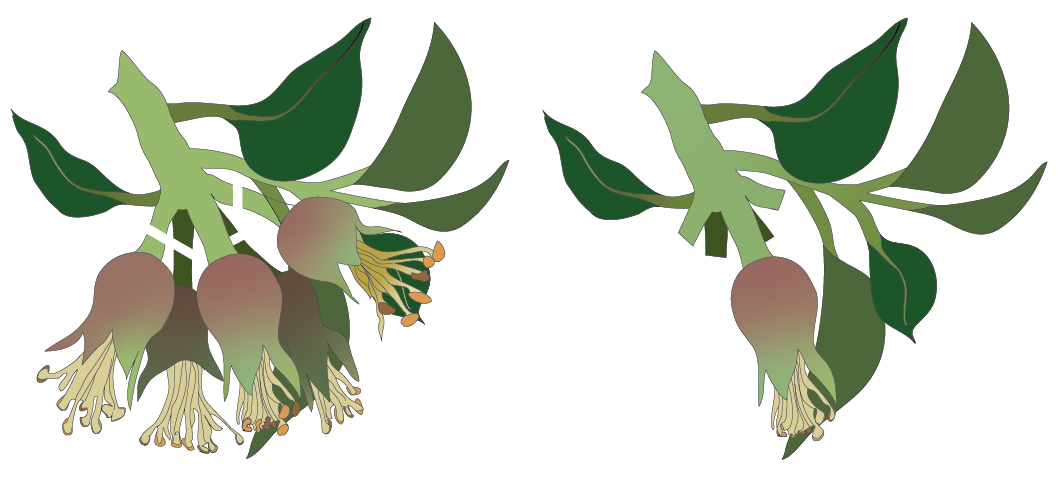
Fruit bagging

A Japanese-style apple bag secured around the single remaining fruit in a thinned apple cluster. Bag is shown as transparent for illustration purposes only.
Fruit bagging can prevent individual fruits from damage and is appropriate for home growers who have a few trees and do not want to use sprays. We recommend trying Japanese-style apple bags sold by some online horticultural suppliers. Results of studies conducted in WARC's orchard in 2019 and 2020 using Ziploc bags and nylon footies showed a reduction—but not an elimination—of infestations, likely because bags were not placed early enough. Additionally, the plastic bags trapped moisture and attracted earwigs, making fruit unappealing. In future studies, alternative bagging materials will be tested.
First, thin fruit (as described above) shortly after petal fall and under dry conditions. Bag the remaining tiny fruit in each cluster, fastening each bag securely around the fruit stem without pinching or bending the stem. Note that you may lose some fruit after bagging due to natural fruit drop—not necessarily because of bagging. Replace bags throughout the season if they blow off or become damaged. Remove bags three weeks prior to harvest to allow adequate ripening.
Trunk banding

Wrapping apple and pear trunks with bands of corrugated cardboard or burlap can capture a portion of cocooning and pupating larvae where they can then be removed and destroyed. This method should be used in combination with other control methods and is most effective for trees with smoother bark. It is also an option in large trees where home spraying is difficult.
Fashion bands of corrugated cardboard four to six inches wide and secure one or more bands tightly around trunks (with corrugations against the trunk) from the base up to a maximum height of about 3' 4". Place the first set by mid-June. Remove, destroy (dispose of as for orchard waste, above), and replace bands in early- to mid-July. Remove and destroy the second set in October.
Encouraging beneficial insects and natural predators
Natural predators of codling moth include birds, bats and beneficial insects like assassin bugs, parasitic wasps and lacewing larvae (CSU Codling Moth in Home Plantings). Learn more about encouraging habitat for birds and bats in your landscape from the Intermountain Fruit Production Guide—Birds and Bats for Pest Suppression. While the release of Trichogramma wasps and entomopathogenic nematodes (EPNs) has been suggested to reduce codling moth, the ability of these predators to control codling moth has not been tested in home plantings and should be considered experimental.
EPNs are a late-season control that targets cocooned larvae on trunks and on the ground beneath trees. Look for the species Steinernema feltiae, which can be obtained from various online retailers. Apply nematodes after harvest in mid to late September when daytime temperatures are still above 50°, humidity is above 85%, and wind is minimal. Make two applications, one week apart. Mix EPN formulations with water according to product instructions and apply with a lance applicator or watering can onto the ground near the base of each tree. If your trees have rough, loose, or cracked bark, spray trunks and lower branch junctions as well, to a height of three feet aboveground. If humidity is low, spray the treatment area with water prior to EPN application and keep the area moist (but not saturated) for at least 24 hours afterwards.
Insect trapping
Attempting to control codling moth with pheromone traps or homemade baited traps does not provide adequate control unless multiple traps are used in a single isolated tree. If unmanaged fruit trees exist within half a mile or more, trapping will be ineffective. Note that bug zappers may attract and kill codling moths but also many other beneficial insects.
Chemical controls
Overuse of chemical sprays has caused pesticide resistance, harm to wildlife and human health, and pollution of water and soils. We recommend using them only as a last resort and in combination with cultural controls described above. Sprays should be applied following the product's label using proper equipment and rates as well as timing based on the insect's life cycle. Both organic and conventional options for controling codling moth are available for home growers. Spray controls can target various life cycle stages of the moth. For example, horticultural oil, which is used to smother eggs, must be timed prior to egg hatch. Insecticides that are labeled for caterpillars will target larvae and are applied during egg hatch. Insecticides are always applied after petal fall and never during bloom when risk to harming pollinators is high.
Some of the organic spray options include the active ingredients spinosad, Bacillus thuringiensis var kurstaki (or Btk), kaolin clay, horticultural oil, and the codling moth granulovirus (CpGV or Cyd-X). Conventional controls include the active ingredients carbaryl, malathion and permethrin. Any chemical spray program should not rely on any one chemical control so as not to cause pest tolerance of a certain chemical and to control insects at various stages. See Table 2 for suggested spray approaches and consult your local Extension office if you have questions about applying chemicals to your trees.
Table 2. Suggested degree-day (DD) treatment timing
This table is intended for use with degree-day models—USPest option “codling moth no biofix (Jones et al 2008)” or TRAPs option “Codling moth - Fixed Biofix.” If you are using either model with the trap-based biofix option, subtract 175 DD from each cumulative DD listed. See the Management Methods section above for details on listed actions.
|
Life Stages |
Cumulative DD |
Actions |
|
1st GENERATION |
||
|
Moth flight begins |
175-200 |
No-spray: bag fruits as soon as possible after petal fall |
|
0% egg hatch |
375 |
No-spray: place trunk bands |
|
15% egg hatch |
525 |
Conventional DFC: if hort oil was applied at 375 DD, apply insecticide now & again in two weeks |
|
54% egg hatch |
675 |
Organic OO: 3rd application of hort oil |
|
Eggs hatching through 1175 DD |
930 |
No-spray: remove/destroy/replace trunk bands |
|
2nd GENERATION (only treat if needed) |
||
|
0% egg hatch |
1255 |
Conventional & organic DFC: apply hort oil once |
|
15% egg hatch |
1525 |
Conventional & Organic DFC: apply insecticide at intervals according to label through end of egg hatch. Check
label for PHI (preharvest interval, or when it’s safe to harvest fruit after the last
spray). |
|
Egg hatching through |
Temperature-dependent actions |
Biological Control: in mid-Sept., make two applications of EPNs, one week apart |
|
3rd GENERATION (only treat if needed) *** |
||
|
Eggs hatching |
2335 – Sept. 15 |
Apply OO and DFC treatments as for 2nd gen. Check product label for PHI. |
* OO: oil-only approach. Begin applications of horticultural oil starting just before budbreak and reapply every 7-10 days as long as significant CM flight is occurring. Oil should only be applied once in second and third generations, just before egg hatch.
** DFC: delayed first cover. Apply horticultural oil once after petal fall. Apply insecticide one week later and repeat at intervals stated on the label. To reduce development of resistance, alternate insecticidal products with each spray or in different seasons. First generation egg hatch begins about three weeks after full bloom, with peak egg hatch beginning about a week later, so be vigilant with control during this period.
*** If temperatures are too cool to produce a 3rd generation, the model DD will plateau prior to the 3rd gen DD listed above. Additionally, reduced day length after mid-September halts codling moth infestation.
Life stages based on http://s3-us-west-2.amazonaws.com/treefruit.wsu.edu/wp-content/uploads/2018/07/opm_table6a.png
Spray timing based on http://treefruit.wsu.edu/article/how-to-effectively-manage-codling-moth/
For more information
For more information on identification, life cycle, and management of codling moth in backyard plantings, visit Colorado State University’s publication, Codling Moth: Control in Home Plantings and UC Davis's publication, How to Manage Pests in Gardens and Landscapes: Codling Moth.
Disclaimer: These recommendations are provided only as a guide. It is always the pesticide applicator’s responsibility, by law, to read and follow all current label directions for the specific pesticide being used. Due to constantly changing labels and product registration, some of the recommendations given in this writing may no longer be legal by the time you read them. If any information in these recommendations disagrees with the label, the recommendation must be disregarded. No endorsement is intended for products mentioned. The authors and Montana State University assume no liability resulting from the use of these recommendations.

